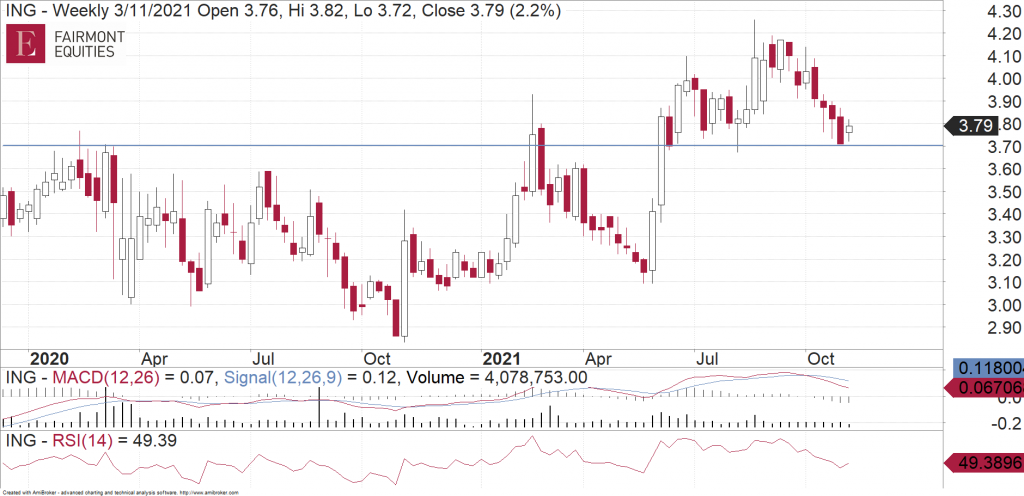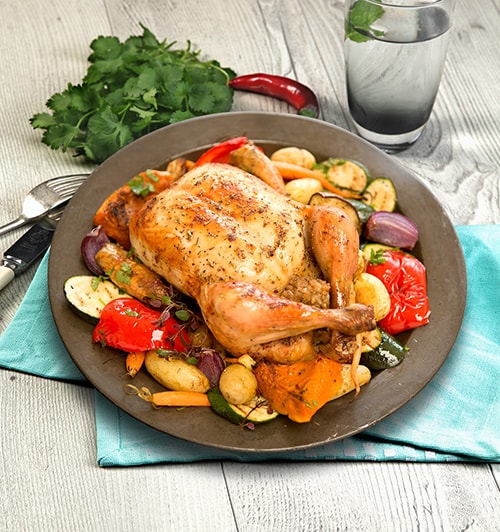Inghams Group (ASX:ING) has navigated the COVID-19 period quite well, as evidenced by above-trend volume growth and resilient pricing during lockdown periods. However, the earnings growth outlook is more dependent on several broader factors and there are potential balance sheet implications should the Company pursue acquisitions. With this in mind, we recently researched the Company to assess the prospects for a re-rating in the shares.
About Inghams Group
Inghams Group is the largest vertically-integrated poultry producer across Australia and NZ, holding the number one and two market positions by value, respectively.
The Company also operates a stockfeed business. This holds strong market positions in the Australian stockfeed and NZ dairy feed markets. The major end markets include the major retailers, Quick Service Restaurant (QSR) operators, food service distributors and wholesalers.
In terms of the earnings composition by country, over 80% of earnings are generated in Australia. The remainder of earnings are generated from NZ.
Key Fundamental Drivers
Volume Growth Highlights Defensive Nature of Poultry Operations
For the Australian operations, revenue growth of 4.8% exceeded volume growth (+3.9%) to a greater degree than that at the group level. This performance was driven by recovery and growth in the QSR and Food Service channels and greater coverage of the Wholesale channel.
In terms of the outlook for volumes in Australia, this is expected to continue to show growth with new business across various channels. Further, it is likely that volume growth will be skewed to 2H22. This is given the recent restrictions on the QSR and Food Service channels. These experienced a sequential decline in turnover in June 2021 as the outbreak of the delta variant of COVID-19 began in Sydney.
Pricing Trends Expected to be Positive Overall
The recent widespread lockdown across Australia at present has impacted retail and other channels, albeit the impact is not as severe as that in the March/April 2020 lockdowns.
There are some signs of inventory build emerging as the QSR and food service channels are disrupted. This may lead to an excess inventory position and/or softer wholesale prices (as the Company has said that excess industry volumes are being redirected to the Wholesale channel).
Having said that, the retail channel (which is ING’s largest, accounting for over 60% of sales) is expected to continue to see strong demand in FY22. To this end, chicken prices in the major supermarkets channel have:
• Remained steady/increased for primary-processed products (i.e. whole chickens and chicken breast fillets)
• Increased for further-processed products (i.e. chicken tenders & chicken nuggets) and
• Remained steady/increased for value-enhanced products
Margin Remains Below Target
Group EBITDA margin increased from 7.0% in FY20 to 7.9% in FY21. The improvement was driven by the realisation of operational cost efficiencies, procurement savings, and the year-on-year benefit in stock obsolescence.
The Company has indicated that it intends to improve the EBITDA margin back to the FY18 level of 8.8%. The uplift implies a potential EBITDA opportunity in the medium term of ~$25m (In context, group EBITDA in FY21 was $209.6m.). The key driver to achieve this target is the cost savings program (‘Optimise the Core’) which is expected to continue to deliver meaningful benefits in excess of inflationary cost increases through operational efficiencies implemented across the entire business.
Benefit From Lower Feed Costs Likely To Be Short-lived
A bumper wheat harvest in late 2020 contributed to wheat prices easing during 2H21 from historical highs for the current crop. Wheat accounts for ~60% of ING’s feed mix, with the balance being sorghum, soybeans, and other vitamins, minerals and oils. The majority of the lower feed cost benefit is expected to flow through in FY22.
However, volatility in international commodity markets has led to domestic pricing (for wheat) holding firmer. This implies that the feed cost benefit in FY22 is likely to be less material than originally expected. In addition, the feed cost benefit may be offset by the anticipated impacts from average selling prices (as discussed above) as well as any cost pass-through mechanisms to customers.
Wheat prices have risen more recently; and this has been driven by strong international demand as production is expected to decline across many of the world’s largest producers (the US, Canada, Russia). Further, the increase in Australian wheat futures poses a higher outlook for ING’s feed costs over the medium term, given that the Company continues to hold between 3-9 months of forward cover.
Balance Sheet Implications from Potential Acquisitions
Gearing (on a net debt to EBITDA basis) declined from 1.7x as at 31 December 2020 to 1.2x as at 30 June 2021. The significant decline in gearing (which is now at the lower end of ING’s target gearing of 1.0-2.0x), was because of strong cash generation in 2H21 and lower capital expenditure.
Given the strong balance sheet position (i.e. low gearing and adequate liquidity) and the unlikelihood of a return of capital to shareholders (given the minimal franking balance), it is likely that the Company will pursue acquisitions.
To this end, there has been recent speculation that ING is interested in Hazeldene’s Chickens which is up for sale and is Australia’s 3rd largest poultry producer (with a 5-10% share). ING has not commented on a potential acquisition of Hazeldene’s but has noted that it will assess any opportunities to advance its strategic agenda.
Whilst an acquisition of Hazeldene’s would make strategic sense for ING, perhaps the more pertinent question regarding a potential acquisition (of Hazeldene’s or others) is the likely impact on ING’s gearing levels. Based on estimates for net debt and EBITDA in FY22, ING could debt-fund up to $200m for acquisitions which would lift gearing to 2.0x, which is the upper end of the Company’s target range.
Given that recent press reports suggest Hazeldene’s could sell for as much as $450m which includes a +$200m property portfolio, the Company would need to undertake an equity raising to fund an acquisition of this size via a combination of debt and equity.
Fundamental View
ING’s current 1-year forward P/E multiple of ~14x is broadly in line with the 2-year average multiple and compares favourably with consensus forecasts for double-digit EPS growth in FY22 & FY23. However, we note a number of factors likely to temper a material re-rating in the shares from current levels:
• Emerging headwinds from higher feed costs, which present a risk for FY23 earnings.
• A likely impact on EBITDA margin (which is still below target levels) from an unfavourable shift in the product mix.
• While there is current balance sheet headroom (with gearing at the bottom end of the target range), cash conversion has been weaker in the last two 1st half periods. As such, we see risk that the continuation of this trend in 1H22 could push gearing levels back higher. Further, that an equity raising may be required to fund a potential acquisition of Hazeldene’s, or, for that matter, any large-scale acquisition (i.e. up to ~$200m), is likely to act as an overhang on the shares.
Charting View
After peaking at the end of August, the ING share price started to roll-over and it now looks vulnerable to hitting lower levels in the short-term. There is major support near $3.70, so a bounce off that would represent a cheaper buy price. Otherwise, a break under that level should lead to further weakness in the share price.

Michael Gable is managing director of Fairmont Equities.
Current share prices available here.
You can learn more about technical analysis in this article.
An 8-week FREE TRIAL to The Dynamic Investor can be found HERE.
Would you like us to call you when we have a great idea? Check out our services.
Disclaimer: The information in this article is general advice only. Read our full disclaimer HERE.
Like this article? Share it now on Facebook and Twitter!

